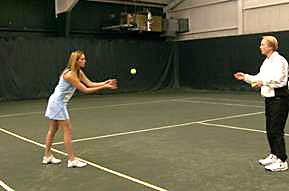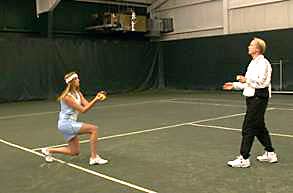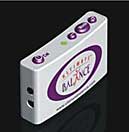|
TennisOne Lessons |
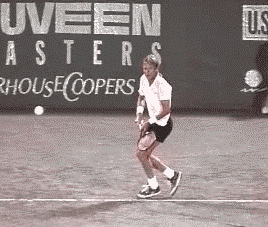 Bjorn Borg shows us here that footwork is the key to balance |
Balance is more than just the ability to not fall over; it involves vision, body position, center of gravity, and coordination, giving players a “feel” for the game that both improves performance and makes tennis more fun.
The three articles in this series provide an overview of balance in the game of tennis and how balance differs in the backcourt and forecourt. Drills are included to help both players (at various levels) and their tennis instructors understand the essential elements of balance in the game and how common balance and coordination problems can be corrected.
Evolving Toward Balance
During the boom days of the sport's popularity, in the late 1960s and early 1970s, tennis players were taught to use the Continental Grip, lean in with their shoulders, and hit the ball out in front. Power came from the shoulders and arms. The top tennis players, like Rod Laver and Tony Roache, had more muscular playing arms than tossing arms. Power was centered in the upper chest; the legs were used just to get to the ball, and then the upper body did the rest.
Vic Braden and Jack Groppel, two of the pioneering sports scientists of our time, came to realize in the mid-1970s that if the hips and large muscles of the legs are not involved in hitting the ball – often due to excessive leaning – shoulder and arm injuries are more likely to occur. At the same time, Bjorn Borg showed that a Western Grip could be hit with an open stance, allowing the ball to be hit closer to the body and using hip rotation for power instead of reaching for the ball. His stroke mechanics allowed Borg to play with a vertical body that provided natural lift with his arms and legs, creating more topspin and better hip rotation that simultaneously developed more power.
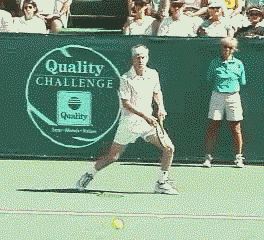 McEnroe's upper body stays vertical and relaxed throughout his entire stroke |
Later, John McEnroe, Miloslav Mecir, and Marcello Rios led a revolution in which players made the game look easy by “quieting” the upper body during even the most aggressive strokes. This allowed them to play with completely vertical spines and relaxed arms. Rotation around this vertical axis increased power in their games and let their arms accelerate at the ball with much less raw strength than previous players required.
These players helped to create the footwork and balance that every top player uses today. They did not listen to coaches tell them to stop and hit, only to have to recover later. Instead, they listened to their “balance,” began to recover before they hit the ball, and were on their way back to center at the contact point, making their movements seamless. These traits enabled them to defeat much bigger and stronger opponents. Today, even tall players like Venus and Serena Williams, Marat Safin and Andy Roddick use the same techniques, and the ball is regularly hit at very high speeds with no more effort involved.
In the new millennium, Roger Federer has raised the bar even further. While his strokes are beautiful and his movement fluid, his most renowned trait is his ability to keep his upper body “quiet,” his head still, and his neck relaxed. With little or no head movement, his vision is better, he has a better sense of where he is on the court in relation to the ball, and he can coordinate his body movements effortlessly. In short, Federer plays tennis in complete balance.
Teaching Balance
Every tennis professional teaches balance at some level. We see students leaning too far one way or the other, making their performance sporadic at best. Through position or stroke work, we get them back on balance and they see and feel improvement, but they go right back to leaning again. The problem is that their sense of balance is based on how they have always moved in the past, not on true balance. Although they have made a correction, they are still unaware of what balance really is.
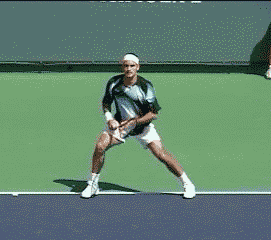 Federer transfers huge power from his hips to the ball, and recovers immediately, with hardly any motion of his upper body or head. |
Let's step back and look at the complete picture. Coaches and instructors need to develop three skills in their students:
- Mechanics – understanding stroke and technique, the fundamentals of the game.
- Mental training – the ability to change old habits, cope with the stress of competition, develop strategies, concentrate, and follow a strict practice schedule.
- Athleticism, balance and coordination – the instinctive ability to respond effectively to the infinite situations presented in competition.
Most instructors have developed an effective toolkit to handle the first two, but it is the third that is the hardest to teach and the least likely to be mastered.
When 15 of the top college tennis coaches were polled on how they teach balance, they replied unanimously that they primarily use agility drills. While these drills can help make a player physically stronger, they do not necessarily help a player move more efficiently. Often, the player spends most of his time lunging around off-balance to get a good workout, rather than attempting to find a balance between effort and desired results. By helping students understand true balance, instructors can help their students acquire the greatest tool in the game: efficient movement that gives them maximum power and saves resources for future shots.
Tennis professionals must understand and teach players the three rules of coordination and balance:
1 - Keep the head still, eyes level, and a head-over-hips-over-feet alignment.
The player must let his eyes “track” the ball, keeping his head upright and still. This attunes his visual acuity and centers his vestibular system, both of which are located in the head and are essential for coordinated movement at high speeds.
2 - All power comes from the center of the body's mass, which is located in the hips
To engage this power, the knees and hips must rotate first to initiate movement. To do this, players - and instructors - must refer to rule #1. If the head and upper body are leaning, rotation throws the body further off balance. Tennis pros must instruct their students to let the ball come close enough to them to hit it comfortably to get maximum power, feel and control; keep their body in alignment; and their power base in their hips. That is, to move appropriately to the ball without lunging or leaning, so that they can produce maximum hip rotation.
3 - Players are responsible for rules #1 and #2
“Feeling” when your body is in balance and when it is not is part of the essential “body sense” needed to be an athlete. Instructors cannot teach how to “feel;” however, they can employ certain drills with their students to help develop this body sense.
|
Drill #1: Toss-and-Catch |
In the next two installments, I will address balance in the backcourt, including fluid court coverage, and balance at the net, including graceful attacking. The drills will focus, respectively, on hip rotation as the key to consistency and power with groundstrokes and on the quickness and accuracy that are necessary for a successful volley game.
General Balance Drills
Below are four drills that players at any level can use to improve their balance technique and “feel.” These drills, including the scenarios in which balance problems most arise, teach players to maintain the essential elements of balance as they hit the ball. While these drills work well alone, done wearing the Ultimate Balance Trainer, they can have a huge impact on a player's awareness of his body movement and balance.
The Ultimate Balance Trainer helps tennis players improve their core balance and reach higher levels of performance through instant feedback during motion. This allows learning to occur through experience and repetition so the tennis instructor can focus on teaching strokes and strategy.
Drill #1: Toss-and-Catch
Problem: Do you track the ball by following it with your head and upper body first and then your feet? Or do you ideally keep your head still and move your feet first, lunging for the ball only if necessary?
Most players track unconsciously with their head and shoulders. This basic balance drill will help you track the ball using your eyes and improve your footwork by moving your hips and legs to reach the ball.
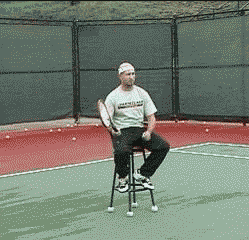 Drill #2: Sit-and-Hit |
Drill: The instructor tosses the ball so that the student needs to catch it at various heights and reaching distances – forward, left and right, and backwards. The key is to move the body to the ball from the hips, rather than bending at the waist to catch it. The Ultimate Balance Trainer will tell the student when her balance is off, and in which direction.
Drill #2: Sit-and-Hit
Problem: Do you hit the ball too late or too early, causing it to go wide right or wide left, into the net, or long off the court? Leaning forward causes you to hit the ball too early, while leaning too far out or leaning backward can cause you to hit the ball late. This drill encourages you to align your head over your hips and wait for the ball to come into your personal ideal hitting zone.
Drill: Using the Ultimate Balance Trainer, the player sits in a chair and hits balls thrown to his forehand and backhand. The goal is to have the player hit the ball when it comes to him, without leaning or reaching for it. The player's feet should remain flat on the ground, with his body vertical.
Drill #3: Sit-and-Twist
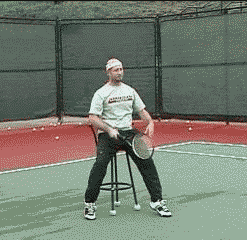 Drill #3: Sit-and-Twist |
Problem: Does your stroke power come from your arm, or do you rotate your body at the hips to create power? When the body does not turn enough, the arm is used for the entire stroke. This causes the arm to wrap around the body, shortening the hitting zone and creating inconsistent shots.
This drill teaches players to rotate their hips to produce power and accuracy by lengthening the hitting zone as the entire body drives through the ball. The arm can consistently produce power or accuracy, but not both. When supported by the power of solid hip rotation, the arm can relax and add direction and “feel” to the stroke.
Drill: This drill is similar to #2; however, the player must rotate his body to add power to his groundstrokes and volleys. The player's feet should roll over as he twists in the chair. Students can progress to a standing position with this drill, rolling just the back foot.
Drill #4: Walk-and-Hit Without Changing Cadence
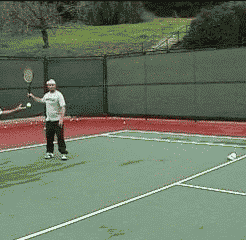 Drill #4: Walk-and-Hit Without Changing Cadence |
Problem: Do you stop and hit shots? Do you overreact and overrun the ball? Or are you moving fluidly around the court? All beginners learn the basic mechanics of footwork and stroke production while standing still. As soon as real play is attempted, however, the student spends an inordinate amount of time and energy stopping and starting. A more dynamic, balanced stroke must be learned so that quick recovery does not get in the way of good stroke technique.
This drill teaches players to move and hit, keeping their weight centered in their hips. They should be taught to move to the ball, without reaching for it. This creates more consistency, better vision of the entire court, and a sense of calm in hitting a tennis ball that many players who work hard have never felt.
Drill: Using the Ultimate Balance Trainer, the student should walk forward, hitting a variety of balls tossed both to his forehand and backhand. The key is to keep moving forward in a straight line, rotating the upper body back and through to hit the shot, rather than stopping and hitting.
My next installment will address balance in the backcourt, including fluid court coverage.
Your comments are welcome. Let us know what you think about Rhys Thomas' article by emailing us here at TennisOne.
![]()
The Ultimate Balance Trainer is now being used at many tennis facilities including Stan Smith's Smith-Stearns Tennis Academy as a teaching tool and at The Boston Athletic Club by Anne Smith as she trains to return to the Pro Tour. It will be shown at the PTR International Tennis Symposium February 23-24, 2005, where Rhys will be speaking about the essentials of teaching balance.
The Ultimate Balance Trainer can be purchased from the company's web site at www.ultimatebalance.com or from oncourt/offcourt. For additional information, please visit www.ultimatebalance.com or call 1-888-225-2620.
![]()
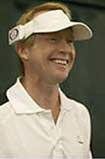 Rhys Thomas
Rhys Thomas
Rhys Thomas is a 25-year USPTA professional, Black Belt in Tae Kwon Do, and a member of the National Head/Penn advisory staff.
He was instrumental in the development of the Ultimate Balance Trainer (www.ultimatebalance.com) as a balance-teaching tool for tennis professionals and other athletic coaches.
Rhys has been Director of Tennis at the Dedham Country and Polo Club in Dedham, Massachusetts, for the last 15 years.

